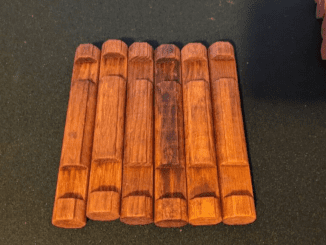In 1839, Lester E. Denison of Middlesex County, Connecticut, patented one of the first hand-operated corn shellers in the United States. Denison’s design featured a rotary crank mechanism that let users insert an ear of corn into a cylinder. As the crank turned, teeth inside the cylinder stripped the kernels from the cob.
As the Industrial Revolution took hold, the demand for corn shellers soared, leading to mass production. Companies like Black Hawk, Keystone Manufacturing Co., and Red Chief emerged as prominent manufacturers, creating various models to meet different farming needs. Some models were designed to be mounted on a wooden box or barrel, allowing the shelled corn to be collected directly into a container below.

How It Works
Inserting the Corn: Users place an ear of corn into the designated slot or opening at the top of the sheller.
Turning the Crank: Users then turn a crank or handle, which rotates a set of gears or wheels equipped with teeth or ridges.
Shelling the Corn: As the corn passes through the sheller’s mechanism, the teeth strip the kernels from the cob, allowing them to fall through a chute or opening into a collection container. The bare cob is ejected separately.
Collecting the Kernels: The kernels typically collect in a basket, box, or sack placed beneath the sheller, ready for storage, sale, or further processing.
Applications and Benefits
Increased Efficiency: The sheller drastically reduced the time and labor needed to shell corn compared to manual methods. This efficiency enabled farmers to process larger quantities quickly, freeing up time for other essential tasks.
Versatility: Manual corn shellers adapted to different types of corn, making them useful for various agricultural contexts, from small family farms to larger commercial operations.
Affordability: Unlike complex machinery, manual corn shellers were affordable and accessible to most farmers, offering a practical solution for increasing productivity without significant financial investment.
Preservation of Crop Integrity: The shellers were gentle enough to preserve the integrity of the kernels, crucial for maintaining corn quality for food products and animal feed.

The manual corn sheller laid the groundwork for developing more advanced agricultural machinery. Its introduction marked a shift towards mechanized farming, paving the way for innovations that continue to shape modern agriculture. Although today’s farms rely on sophisticated, motorized equipment, the principles of efficiency and innovation embodied by the manual corn sheller remain relevant.
Today, antique manual corn shellers are highly sought after by collectors and history enthusiasts. They represent a bygone era of farming and serve as tangible reminders of the ingenuity and resilience of early agricultural communities. Many antique shellers are displayed in museums, agricultural exhibits, and private collections, preserving their historical significance.
Beyond their historical and collectible value, manual corn shellers offer educational insights into the evolution of farming technology. They provide a hands-on way to teach about past agricultural practices and the progression of technological advancements over time.
The antique manual corn sheller stands as a testament to human ingenuity and the drive to improve agricultural efficiency. Its history is rich with innovation, and its usage spans generations of farmers who relied on its practicality.
Although modern machinery has largely replaced manual methods, the legacy of the corn sheller endures as a symbol of progress and the enduring spirit of those who work the land. Whether admired for its historical significance, collected for its nostalgic charm, or studied for its role in agricultural evolution, the manual corn sheller remains an important piece of our farming heritage.


